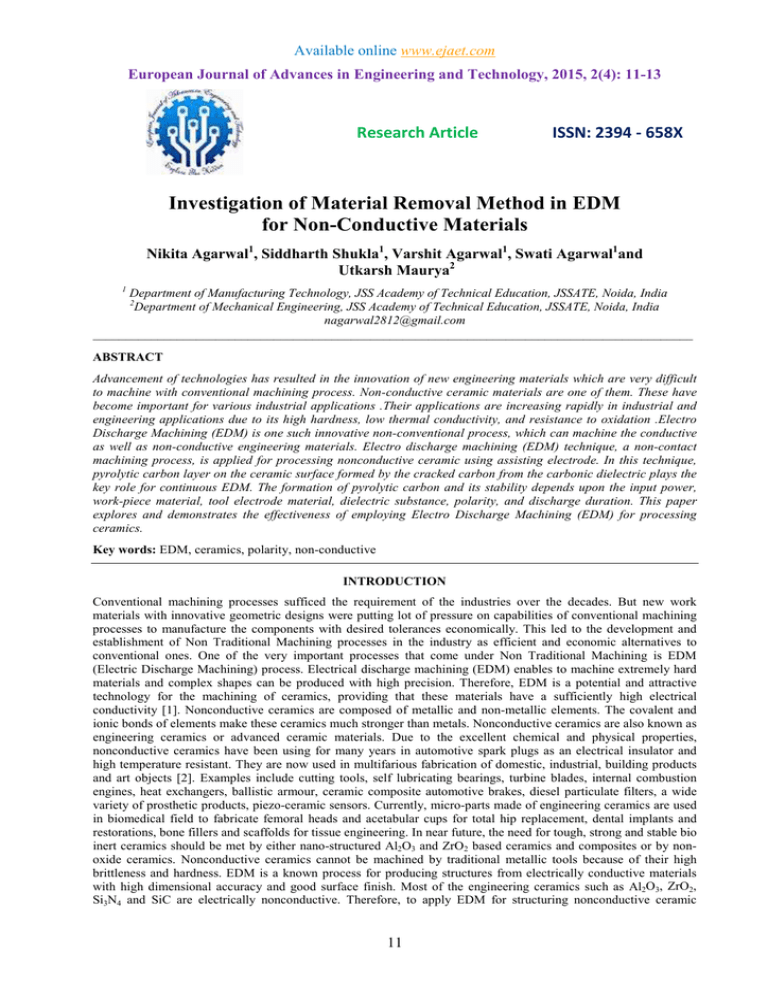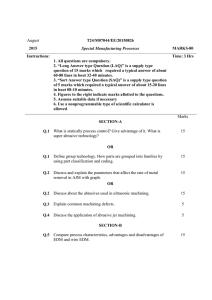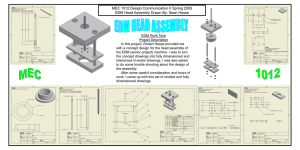Investigation of Material Removal Method in EDM for Non
advertisement

Available online www.ejaet.com European Journal of Advances in Engineering and Technology, 2015, 2(4): 11-13 Research Article ISSN: 2394 - 658X Investigation of Material Removal Method in EDM for Non-Conductive Materials Nikita Agarwal1, Siddharth Shukla1, Varshit Agarwal1, Swati Agarwal1and Utkarsh Maurya2 1 Department of Manufacturing Technology, JSS Academy of Technical Education, JSSATE, Noida, India 2 Department of Mechanical Engineering, JSS Academy of Technical Education, JSSATE, Noida, India nagarwal2812@gmail.com _____________________________________________________________________________________________ ABSTRACT Advancement of technologies has resulted in the innovation of new engineering materials which are very difficult to machine with conventional machining process. Non-conductive ceramic materials are one of them. These have become important for various industrial applications .Their applications are increasing rapidly in industrial and engineering applications due to its high hardness, low thermal conductivity, and resistance to oxidation .Electro Discharge Machining (EDM) is one such innovative non-conventional process, which can machine the conductive as well as non-conductive engineering materials. Electro discharge machining (EDM) technique, a non-contact machining process, is applied for processing nonconductive ceramic using assisting electrode. In this technique, pyrolytic carbon layer on the ceramic surface formed by the cracked carbon from the carbonic dielectric plays the key role for continuous EDM. The formation of pyrolytic carbon and its stability depends upon the input power, work-piece material, tool electrode material, dielectric substance, polarity, and discharge duration. This paper explores and demonstrates the effectiveness of employing Electro Discharge Machining (EDM) for processing ceramics. Key words: EDM, ceramics, polarity, non-conductive INTRODUCTION Conventional machining processes sufficed the requirement of the industries over the decades. But new work materials with innovative geometric designs were putting lot of pressure on capabilities of conventional machining processes to manufacture the components with desired tolerances economically. This led to the development and establishment of Non Traditional Machining processes in the industry as efficient and economic alternatives to conventional ones. One of the very important processes that come under Non Traditional Machining is EDM (Electric Discharge Machining) process. Electrical discharge machining (EDM) enables to machine extremely hard materials and complex shapes can be produced with high precision. Therefore, EDM is a potential and attractive technology for the machining of ceramics, providing that these materials have a sufficiently high electrical conductivity [1]. Nonconductive ceramics are composed of metallic and non-metallic elements. The covalent and ionic bonds of elements make these ceramics much stronger than metals. Nonconductive ceramics are also known as engineering ceramics or advanced ceramic materials. Due to the excellent chemical and physical properties, nonconductive ceramics have been using for many years in automotive spark plugs as an electrical insulator and high temperature resistant. They are now used in multifarious fabrication of domestic, industrial, building products and art objects [2]. Examples include cutting tools, self lubricating bearings, turbine blades, internal combustion engines, heat exchangers, ballistic armour, ceramic composite automotive brakes, diesel particulate filters, a wide variety of prosthetic products, piezo-ceramic sensors. Currently, micro-parts made of engineering ceramics are used in biomedical field to fabricate femoral heads and acetabular cups for total hip replacement, dental implants and restorations, bone fillers and scaffolds for tissue engineering. In near future, the need for tough, strong and stable bio inert ceramics should be met by either nano-structured Al2O3 and ZrO2 based ceramics and composites or by nonoxide ceramics. Nonconductive ceramics cannot be machined by traditional metallic tools because of their high brittleness and hardness. EDM is a known process for producing structures from electrically conductive materials with high dimensional accuracy and good surface finish. Most of the engineering ceramics such as Al2O3, ZrO2, Si3N4 and SiC are electrically nonconductive. Therefore, to apply EDM for structuring nonconductive ceramic 11 Agarwal et al Euro. J. Adv. Engg. Tech., 2015, 2(4):11-13 ______________________________________________________________________________ materials, a basic technique is developed in which a conductive metallic layer is applied on the surface of the workpiece. This additional conductive metallic layer is referred as assisting electrode (AE). The initial electrical sparks occur in the machining gap between the tool electrode and the assisting conductive electrode. In this method, kerosene is used as dielectric fluid. After the finishing of AE layer, carbon particles are cracked due to the disassociation of kerosene molecule at high instantaneous energy and create a layer of pyrolytic carbon on the machined surface of the electrically nonconductive ceramic. This carbonic layer provides the essential electrical conductivity to progress the process. Adhesive copper or aluminium foil, coating of graphite or carbon, silver varnish and copper, silver or gold sputtered on the work-piece surface can be used as AE [3]. LITERATURE REVIEW In [1], Lauwers et al suggested that besides the typical EDM material removal mechanisms, such as melting/evaporation and spalling, other mechanisms can occur such as oxidation and dissolution of the base material. They also concluded that the spalling effect is strongly related to the formation of cracks. Siva Shanker et al [2] suggested that Conductive ceramics can be easily machined by EDM and nonconductive ceramics and can be made machinable by EDM, by doping them with conductive materials. They used Al-alloy, Silicon carbide composite to analyze the effect of grain size of SiC and its percentage (which affects the electrical conductivity) on the machining rate. Sabur et al [3] suggested that material is removed in EDM of nonconductive ZrO2 ceramic mostly by spalling and it increases with the increase of input power. EXPERIMENTAL SET-UP The ZrO2 ceramic work-piece machined by EDM .Cavities of various depths such as 1.0 mm, 2.0 mm, and 4.0 mm are created on the ZrO2 workpiece. The pyrolytic carbon layer on the machined surface is produced continuously using kerosene as dielectric fluid and adhesive copper foil as initial assisting electrode. The main material removal mechanism in EDM of nonconductive ceramic materials is spalling. However, a small fraction of ceramic materials can be removed by melting and vaporization. In the SEM images, several cracks are observed and it clearly reveals that the most of the material is removed due to spalling. Spalling also depends on the input energy. A minimum input power is required to create the pyrolytic carbon layer on the ceramic surface. The present experiment shows that at lower input powers, EDM could not be progressed on ZrO2. The minimum input power of 1.1 KVA could start the machining creating a thin layer of pyrolytic carbon with very low MRR. Stable machining is attained at 1.2 KVA and more materials are removed at increased input powers. The effect of input power on the MRR is shown in Fig. 2. It is evident that MRR increases with the increase of input power at initial stages. This trend remains same from the input power of 1.1 KVA until 1.3 KVA. From 1.3 to 1.4 KVA, it is increased at lower rate (curve is less stiff). However, more experiments are needed to confirm the trend [2]. Fig. 1 Schematic diagram of the experimental setup 12 Agarwal et al Euro. J. Adv. Engg. Tech., 2015, 2(4):11-13 ______________________________________________________________________________ Fig. 2 The effect of IP on MRR in EDM of nonconductive ZrO2 using adhesive copper foil as assisting electrode, copper tool electrode with –ve polarity at Ton=12 s and Toff =12 s CONCLUSION Nonconductive ZrO2 ceramic was machined by die-sinking EDM machine applying assisting electrode method. The effect of input power on material removal characteristics was investigated. Following conclusions can be drawn from the experimental observations and results [2]. 1. Using adhesive copper foil as assisting electrode and copper tool electrode with –ve polarity in kerosene dielectric, EDM of nonconductive ZrO2 ceramic is done effectively [2]. 2. In the EDM of nonconductive ZrO2 ceramic, the material is removed mainly by spalling. A little amount of material is removed by melting and vaporization [2]. 3. The material removal can be increased by increasing the input power keeping other parameters constant.[2] 4. After EDM, the external copper layer can be removed from the ceramic surface easily [2]. REFERENCES [1] B Lauwers, JP Kruth W Liu, W Earaerts, B Schacht and P Bleys, Investigation of Material Removal Mechanisms in EDM of Composite Ceramic Materials, Journal of Materials Processing Technology, 2004,149, 347–352. [2] Abdus Sabur, Mohammad Yeakub Ali, Md Abdul Maleque and Ahsan Ali Khan, Investigation of Material Removal Characteristics in EDM of Nonconductive ZrO2 Ceramic, Procedia Engineering, 2013, 56, 696 – 701. [3] N Siva Shanker, A Parashuramulu, K Buschaiah and P Laxminarayana, Processing of Ceramics and Metal Matrix Composites with Electro Discharge Machining, Advanced Materials Research, 2013, 699, 864-868. 13



